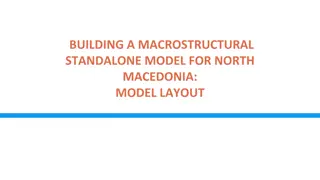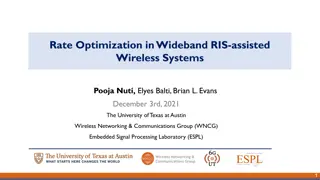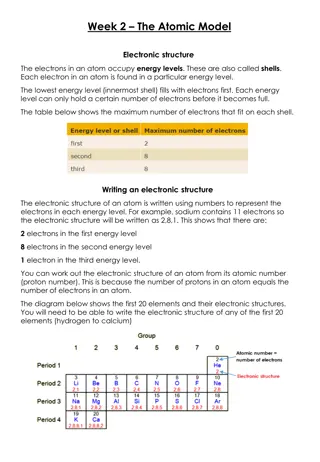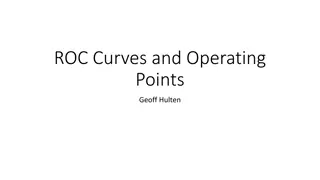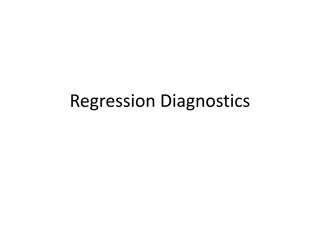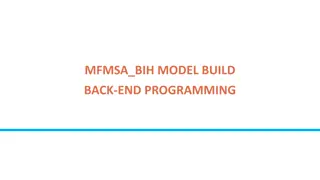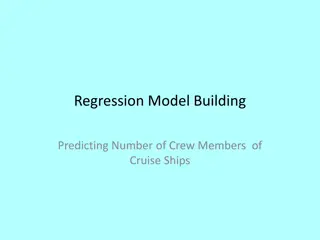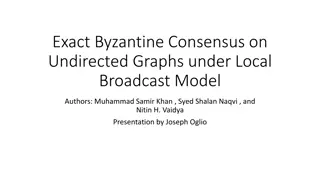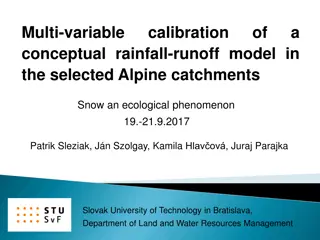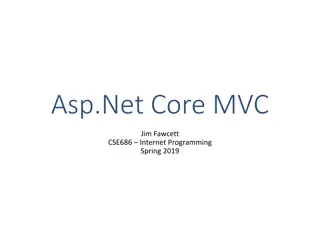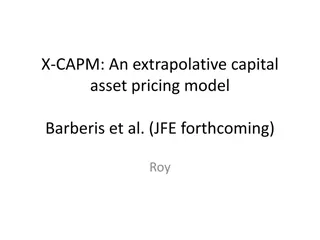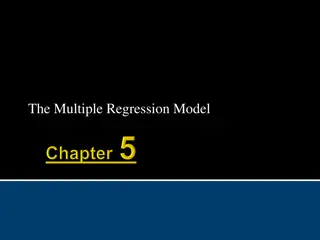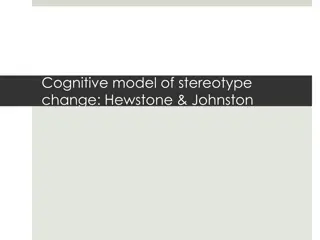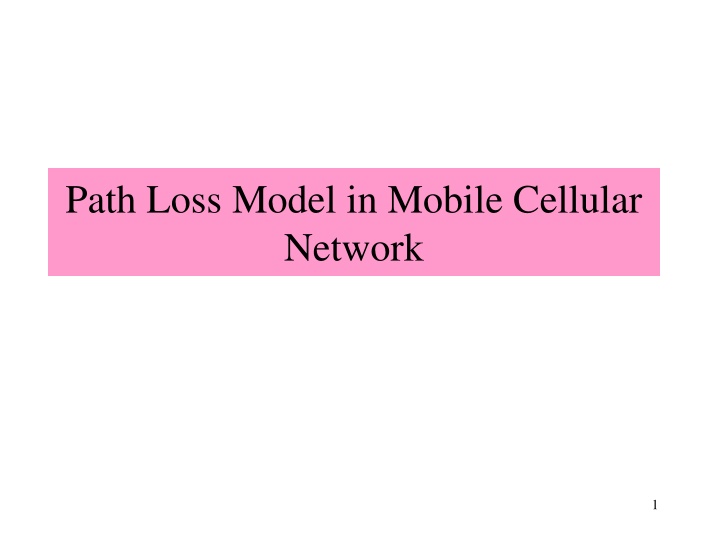
Understanding Path Loss Models in Mobile Cellular Networks
Explore different path loss models in mobile cellular networks, such as the Walfish-Ikegami model and the Okumura-Hata model. Learn about their empirical formulations and application in various urban and rural areas, along with suitable frequency ranges and antenna height considerations.
Download Presentation

Please find below an Image/Link to download the presentation.
The content on the website is provided AS IS for your information and personal use only. It may not be sold, licensed, or shared on other websites without obtaining consent from the author. If you encounter any issues during the download, it is possible that the publisher has removed the file from their server.
You are allowed to download the files provided on this website for personal or commercial use, subject to the condition that they are used lawfully. All files are the property of their respective owners.
The content on the website is provided AS IS for your information and personal use only. It may not be sold, licensed, or shared on other websites without obtaining consent from the author.
E N D
Presentation Transcript
Path Loss Model in Mobile Cellular Network 1
Walfish-Ikegami Model Okumura-Hata Model 2
Okumura-Hata Model Microcellular areas span a few Kms. Okumura in 1968 drew some path-loss curve in the range of 100MHz to 1920 MHz Masaharu Hata developed empirical path-loss model based on measurement of Okumura known as Okumura-Hata model. Here separation between BS and MS is greater that 1Km. 3
Empirical formulation of data provided by the Okumura model and is valid for frequencies in the range 150MHz- 1500MHz = + ( )( ) 69 55 . 26 16 . (log ) 13 82 . (log ) ( ) L + Urban 9 . 44 dB 55 f h a h m ( c BS MS . 6 log ) log h d BS For large city, 2 . 8 29 (log . 1 54 ) 1 . 1 ; 300 h dB for f MHz MS c = ( ) a h MS 2 2 . 3 (log 11 . 75 ) 9 . 4 ; 300 h dB for f MHz MS c For small and medium city, = ) 7 . 0 . 1 ( ) 8 . 0 ( ) 1 . 1 ( log 56 log a h f h f dB MS c MS c 4
For suburban and open rural area, = 2 ( )( ) Urban ( )( ) [(log( 2 / 28 )] 4 . 5 L Suburban dB L dB f dB m m c = {log( 78 . 4 + 2 ( )( ) Urban ( )( ) )} 18 33 . log 40 94 . L rural dB L dB f f dB m m c c The model is suitable for a distance above 1 Km. The model does not support path specific correction Coverage Frequency: 150 MHz to 1500 MHz Mobile Station Antenna Height: between 1 m and 10 m Base station Antenna Height: between 30 m and 200 m Link distance: between 1 km and 20 km. 5
The WalfishIkegami model is an empirical propagation model for an urban area, which is especially applicable for micro cells but can also be used for macro cells. Model Parameters: The mean value for street widths (w) is given in metres and the road orientation angle ( or ) in degrees. The mean value for building heights (hroof) is an average over the calculation area and is given in metres. The mean value for building separation (b) is calculated from the centre of one building to the centre of another building and is also given in metres. 7
WalfishIkegami model is suitable for frequencies 800MHz to 2000 MHz where distance can be very small like 200m. Range of BS antenna height 4 to 50m and that of MS is 1 to 3m. Distance in the range of 20m to 5Km. 8
For LOS case, Lm(db) = 42.6 +26log(d) + 20log(fc); d 20m For NLOS case, we have to consider, Hroof = Height of roof-top hBS = hBS - hroof hMS = hroof - hMS w: width of street in meter b: Building separation in meter along the radio path : Road orientation w.r.t. the direction of radio propagation in degrees incident angle relative to the street). 9
NLOS path loss composed of three terms, LP(DB) = L0 + Lrts + Lmsd The model works best for the BS much taller than the surrounding buildings. L0: Free space path loss = 32.4 + 20log(d) + 20log(fc) Lrts: roof-street diffraction and scatter loss = -16.9 -10log(w) + 10log(fc) + 20log( hm) + Lori Lori is the street orientation loss: + = 114 . 0 0 . 4 5 . 2 + . 0 35 0 10 . 0 354 ; 0 35 0 0 ( ) 075 ( 35 ; ) 55 L ori 0 0 ( 55 ; ) 55 90 10
Lmsd = multiscreen diffraction loss = Lbsh+ Ka + Kdlog(d) + Kflog(fc) - 9log(b) ( ) + 18 log( 11 ) ; BTS h roof h BTS h roof h = L bsh 0 ; BTS h roof h 54 ; BTS h ( 8 . 0 roof h = 54 ); 5 . 0 K BTS h roof h d Km and BTS h roof h a 54 ( 6 . 1 ) ; 5 . 0 BTS h roof h d d Km and BTS h roof h 11
18 ; BTS h h roof h = K BTS h d roof h 18 15 ; BTS h roof h roof h MS f 7 . 0 1 ; medium city and suburban centers 925 = + 4 Kf f 5 . 1 1 ; urban centers 925 The parameter Ka increases the path loss in case the BTS is below the rooftop. The parameters Kd and Kf are for adjusting the correction between the distance and frequency with multiscreen diffraction. 12
Example:1 Find cell radius for the following parameters. fc =1800MHz Street width (w) = 20m Spacing between buildings (b) = 40m Average roof height (hroof) = 40m Mobile antenna height (hm) = 2m BS antenna height (hb) = 40m Street orientation = 900 Allowable path loss =140dB 13
hBS = hBS hroof = 40 40 = 0 hMS = hroof hMS = 40 2 = 38m Orientation loss, Lori = 4 - 0.114( - 55) = 0.001 Lbsh = -18log(11) + (hBS - hroof) = -18.75dB Ka = 54 Kf = 4 + 1.5(fc/925 -1) = 5.42 The roof street diffraction and scatter loss, Lrts = -16.9 -10log(w) + 10log(fc) + 20log( hMS) + Lori = -16.9 -10log(20) + 10log(1800) + 20log(38) + 0.001 =34.25dB 14
Free space path loss, L0 = 32.4 + 20log(r) + 20log(fc) = 97.5 + 20log(r) dB Multi screen diffraction loss, Lmsd = Lbsh+ Ka+ Kflog(fc) - 9log(b) = 38.47 + 18log(r) dB Allowable path loss, 140 = L0 + Lmsd + Lrts= 97.5 + 20log(r) + 38.47 +18log(r) + 34.25 Or, 38log(r) = -30.23 Or, r = 0.16Km = 160m 15
Large Scale Path Loss Propagation model that predict the mean signal strength (not rapid change in amplitude of signal) for an arbitrary transmitter- receiver (T-R) separation distance are useful in estimating the radio coverage area of a transmitter are called large-scale propagation models. Since they characterize signal strength over large T-R separation (several hundreds or thousands of meters). On the other hand, propagation model that characterize the rapid fluctuations of the received signal strength over very short travel distance (few wavelengths) or short time duration (on the order of seconds) are called small-scale or fading models. 16
Fig.1 Small and large scale fading Fig.1 shows the small scale fading (signal fades rapidly) and the more gradual large scale (local average signal) variation for an indoor radio communication system. 17
The three Basic Propagation Mechanisms 18
The three Basic Propagation Mechanisms Reflection, diffraction and scattering are the three basic propagation mechanisms which impact propagation in mobile communication system. Reflection Reflection occurs when a propagating EM wave impinges upon an object which has very large dimensions compared to wavelength of the propagating wave. Reflection occur from the surface of the earth and from buildings and walls. 20
Diffraction Diffraction occurs when the radio path between the transmitter and receiver is obstructed by a surface that has sharp irregularities (edges). The secondary waves resulting from the obstructing surface are present throughout the space and even behind the obstacle, giving rise to a bending of waves around the obstacle, even when the LOS path does not exist between T and R. Diffraction depends on the geometry of the object as well as the amplitude, phase and polarization of the incident wave at the point of diffraction. 21
Scattering Scattering occurs when the medium through which the wave travels consists of objects with dimension that are small compared to the wavelength and where the number of obstacles per unit volume is large. Scattered waves are produced by rough surfaces, small objects or by other irregularities in the channel. Absorption Attenuation by solid material (for example wall) 22
Diffraction T R 1st Fresnel zone Obstruction Diffraction occurs when waves hit the edge of an obstacle Secondary waves propagated into the shadowed region Excess path length results in a phase shift 23
Huygens Principle All points on wave front can be considered as point sources to produce secondary wavelets and these wavelets combine (vecctor sum) to form a new wave in the direction of propagation. 24
Diffraction Phenomena: Radio signal can propagate around the curved surface of the earth, beyond the horizon and behind obstructions. Although the received field strength decreases rapidly as a receiver moves deeper into the obstructed ( shadowed ) region, the diffraction field still exists and often has sufficient strength to produce a useful signal. The field strength of a diffracted wave in the shadowed region is the vector sum of the electric field components of all the secondary wavelets in the space around the obstacles. 25
h T R d1 d2 Consider a transmitter and receiver separated in free space and an obstructing screen of effective height h with infinite width be placed between them at a distance d1 from the transmitter and d2 from the receiver. It is apparent that the wave propagating from the transmitter to receiver via top of the screen travels a longer distance than if a direct LOS. 26
Derive the path length difference, h T R d1 d2 The corresponding phase difference, Fresnel-Kirchoff diffraction parameter, Therefore Which Depends on h, position of obstacle and location transmitter and receiver 27
Knife-edge Diffraction Model Huygen s secondary source h R d1 d2 Knife edge obstruction When shadowing is caused by a single object such as a hill or mountain, the attenuation caused by diffraction can be estimated by treating the obstruction as a diffracting knife edge. This is the simplest of diffraction models and the diffraction loss in this case can be readily estimated using the classical Fresnel solution for the filed behind a knife edge. 28
Consider a receiver at point R in the shadow region (also called the diffraction zone). The field strength a point R in above fig is a vector sum of the fields due to all of the secondary Huygen s sources in the plane above the knife edge. 29
The electric field strength, Ed of a knife edge diffraction wave is, Where E0 is the free space field strength in the absence of both the ground and the knife edge and F(v) is the complex Fresnel integral. The Fresnel integral F(v) is a function of the Fresnel- Kirchoff diffraction parameter v. 30
The diffraction gain due to the presence of a knife edge, as compared the free space E-field. Gd(dB) = 20log|F(v)|. An approximate solution of above equation is, 31
Fresnel zones under different knife-edge diffraction scenarios h d1 d2 h d1 d2 and v are positive since h is positive and v are 0 since h is 0 h A family of ellipsoids can be constructed between transmitter and receiver by joining all points for which the excess path delay is an integral multiple of /2. represent Fresnel zones. d1 d2 The ellipsoids and v are negative since h is negative 32
Example-1 For the following geometry determine (i) loss due to knife edge diffraction and (ii) height of the obstruction due to 6dB diffraction loss where f = 900MHz. T 100m R 50m 25m 10Km 2Km 36
Redrawing the geometry subtracting the height of the smallest structure 75m 25m 2Km 10Km The wavelength, 8 3 10 1 c = = = m 6 3 f 900 10 75 75 25 = = 1 0 tan . 2 15 = = 1 0 tan 2865 . 0 2000 10000 = + = 0= . 2 434 . 0 0424 rad 37
Now Fresnel-Kirchoff diffraction parameter, 2 10000 2000 + = = . 0 0424 . 4 24 v / 1 ( ) 3 10000 ( 2000 ) The diffraction gain due to the presence of a knife edge, . 0 225 . 0 225 = = = ( ) 20 log 20 log 25 5 . Gd dB dB . 4 24 v ii) For 6dB diffraction loss, v = 0, + d ( 2 ) d d = = 1 d 2 0 v h 1 2 = 38 0 h
Therefore the knife edge obstruction just touch the LOS. The geometry will take the form, T 25m H 2Km R 10Km 25 H = 2000 12000 = . 4 16 H m 39
Scattering Received signal strength is often strongerthan that predicted by reflection/diffraction models alone The EM wave incident upon a rough or complex surface is scattered in many directions and provides more energy at a receiver energy that would have been absorbed is instead reflected to the Rx. Scattering is caused by trees, lamp posts, towers, etc. flat surface EM reflection (one direction) rough surface EM scattering (many directions) 40
Scattering When a radio wave impinges on a rough surface, the reflected energy is spread out (diffused) in all directions due to scattering. Flat surfaces that have much larger dimension than a wavelength may be modeled as reflective surfaces. However the roughness of such surfaces often induces propagation effects different from the specular reflection. Surface roughness is often tested using the Rayleigh criterion which defines a critical height (hc) of surface protuberances for a given angle of incidence i given by, hc= /8sin( i) A surface is considered smooth if its minimum to maximum protuberance h is less than hc and is considered rough if the protuberance is greater than hc. 41
rough surface ch smooth surface ch 42

